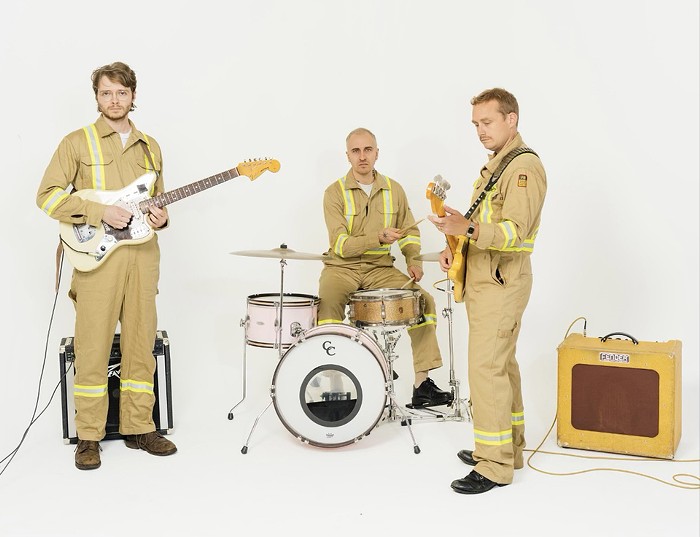GNARLS BARKLEY
The Odd Couple
(Atlantic)
![]()
![]() 1/2
1/2
I can't imagine DJ Danger Mouse and Cee-Lo study sales charts all that obsessively, but if they did, they recognized that even in the iPod era, and even with a hit single like "Crazy," it was the full album St. Elsewhere that scorched the charts. Makes sense, then, that they went for a more cohesive, flowing disc this time, and though that may drive their label's download division nuts, the duo's newfound comfort and calm doesn't sink the ship.
Gnarls Barkley's original novelty—digital slicer-and-dicer meets analog crooner-and-crier—has since passed, and the creative process on The Odd Couple is audibly different as a result. If Couple isn't more collaborative, it's at least more organic; Mouse still mines the jangle and style of '60s mod/garage rock, but St. Elsewhere's jittery production has given way to slower, darker, and fuller backbeats, littered with instrumental samples that sound like they came from a session band rather than a stack of records.
This works out in Cee-Lo's favor; with the help of this slower tempo and mood, the singer creates what may very well be his true vision of soul pop, something he only hinted at with the last album's hits. Not that the duo have lost their upbeat genius—"Going On" is a memorable call to arms, while the dub undertones in "Surprise" are an interesting foil to its doo-wop harmonies. But Cee-Lo's songwriting and delivery on chilled, semi-rock tracks such as "Who's Gonna Save My Soul" and "Whatever" find the duo at their most unique and memorable, and it's this range—not just the impact of hard-hitting singles—that might give Gnarls Barkley life beyond "Crazy." SAM MACHKOVECH
MOBY
Last Night
(Mute)
![]()
![]()
![]()
Of course Last Night isn't groundbreaking. That's not what Moby ever did. He was the first techno artist to try crossing over to the big bad mainstream for a reason: Dude's senses of tune and production were both pretty pop from the beginning, and his best work (1993's Move, 1995's Everything Is Wrong, 1999's Play) benefits from his sense of reach. But his last two albums, 2002's 18 and 2005's Hotel, bleached the Play formula till it bled white, and based on the eight-minute "mega-mix" leaked on RCRDLBL.com a while back, I had basically no hopes for this one.
So to say that Last Night is a lot better than its predecessors isn't going to sound like much. And Moby's simple sensibility for tune, beat, and effects haven't shifted any, either. (Lots of dance-music lovers dislike Moby not because he's too popular, but because his sonics don't work hard enough at surprising the listener.) But when the goal is plainly to keep things simple enough to make the listener want to stick around for a while, Moby succeeds; this is his most charming music in a while.
Not only does Moby "go back to his roots" here, he copies himself outright at times, sounding like he's rediscovering how enjoyable his old records can be. The frantic "The Stars" and the lissome "I Love to Move in Here" could be mistaken for outtakes from the Early Underground compilation: simple beats, seams-showing vocal samples, nifty little mnemonic piano, funny Casio-preset keyboards, strings ghosting the melody. "Everyday It's 1989" is the kind of rave anthem that made his bread and butter. (Screaming divas: yes.) Last Night drags in the middle, an exercise in vocal songwriting that's mostly negligible. But the rest grows on you. MICHAELANGELO MATOS
THE RUBY SUNS
Sea Lion
(Sub Pop)
![]()
![]()
![]()
The cover art of the Ruby Suns' sophomore album, Sea Lion, is a faux-childlike drawing of a young boy standing on a rock in the ocean, wearing a feathered headdress and projecting a kind of mobile from his outstretched hands; in the distance are twin islands dotted with cozy, chimney-smoking houses. It's pretty hard not to read as biographical.
The child, one might infer, is the world-traveling, California-born Ryan McPhun, lead singer and songwriter of the band formerly known as Ryan McPhun and the Ruby Suns, now handily abbreviated. The islands in the distance would be McPhun's adopted home (and recent Sub Pop group vacation destination), New Zealand. The headdress and mobile, representing the sonic trinkets collected on McPhun's trusty Dictaphone during his rock-hopping travels from Auckland to Africa to Thailand.
Because while McPhun's songs are basically hazy, acoustic folk-rock, they're dressed up with all matter of passport-stamped jetsam: hula harmonies on "Oh, Mojave," tribal drumming and guitars on "Tane Mahuta," lapping waves of reverb on "It's Mwangi in Front of Me," Phil Spector–drums on (the abominably titled) "Kenya Dig It?" The result can feel scattered, but it's held together by McPhun's soft-spoken singing and watery-deep bedroom productions, which recall the early work of fellow Sub Popsters and Ruby Suns tourmates, the Shins.
McPhun's voice is absent on the album's most outstanding track, though. On the gliding, galaxy-gazing dream-pop ballad "There Are Birds," bandmate Amee Robinson steps to the mic to deliver a gorgeously sedated anthem that longs for a place of sanctuary among all the album's far-flung travels. ERIC GRANDY
The Ruby Suns play on Tues April 1 with Le Loup, Chop Suey, 8 pm, $8, 21+.
The Dude and Walter ![]()
![]()
![]()
![]()
Wayne and Garth ![]()
![]()
![]()
Freddy and Jason ![]()
![]()
Napoleon and Pedro ![]()


















